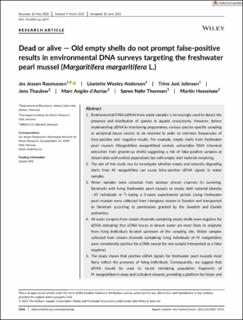| dc.contributor.author | Rasmussen, Jes Jessen | |
| dc.contributor.author | Andersen, Liselotte Wesley | |
| dc.contributor.author | Johnsen, Trine Just | |
| dc.contributor.author | Thaulow, Jens | |
| dc.contributor.author | Anglès d'Auriac, Marc | |
| dc.contributor.author | Thomsen, Søren Nøhr | |
| dc.contributor.author | Hesselsøe, Martin | |
| dc.date.accessioned | 2021-09-22T09:10:00Z | |
| dc.date.available | 2021-09-22T09:10:00Z | |
| dc.date.created | 2021-09-15T14:08:41Z | |
| dc.date.issued | 2021 | |
| dc.identifier.citation | Aquatic conservation. 2021, 31 (9), 2506-2514. | en_US |
| dc.identifier.issn | 1052-7613 | |
| dc.identifier.uri | https://hdl.handle.net/11250/2780270 | |
| dc.description.abstract | Environmental DNA (eDNA) from water samples is increasingly used to detect the presence and distribution of species in aquatic ecosystems. However, before implementing eDNA in monitoring programmes, various species-specific sampling or analytical issues remain to be resolved in order to minimize frequencies of false-positive and -negative results. For example, empty shells from freshwater pearl mussels (Margaritifera margaritifera) contain extractable DNA (chemical extraction from ground-up shells) suggesting a risk of false-positive samples at stream sites with extinct populations but with empty shell material remaining. The aim of this study was to investigate whether empty and naturally degrading shells from M. margaritifera can cause false-positive eDNA signals in water samples. Water samples were collected from outdoor stream channels (in Lemming, Denmark) with living freshwater pearl mussels or empty shell material (density ~10 individuals m−2) during a 3-week experimental period. Living freshwater pearl mussels were collected from Hemgravs stream in Sweden and transported to Denmark according to permissions granted by the Swedish and Danish authorities. All water samples from stream channels containing empty shells were negative for eDNA indicating that eDNA traces in stream water are most likely to originate from living individuals located upstream of the sampling site. Water samples collected from stream channels containing living individuals of M. margaritifera were consistently positive for eDNA except for one sample (interpreted as a false negative). The study shows that positive eDNA signals for freshwater pearl mussels most likely reflect the presence of living individuals. Consequently, we suggest that eDNA should be used to locate remaining population fragments of M. margaritifera in deep and turbulent streams, providing a platform for faster and more efficient decision making when launching investigative and mitigation initiatives. | en_US |
| dc.language.iso | eng | en_US |
| dc.publisher | Wiley | en_US |
| dc.rights | Navngivelse 4.0 Internasjonal | * |
| dc.rights.uri | http://creativecommons.org/licenses/by/4.0/deed.no | * |
| dc.title | Dead or alive — Old empty shells do not prompt false-positive results in environmental DNA surveys targeting the freshwater pearl mussel (Margaritifera margaritifera L.) | en_US |
| dc.type | Peer reviewed | en_US |
| dc.type | Journal article | en_US |
| dc.description.version | publishedVersion | en_US |
| dc.rights.holder | © 2021 The Authors | en_US |
| dc.source.pagenumber | 2506-2514 | en_US |
| dc.source.volume | 31 | en_US |
| dc.source.journal | Aquatic conservation | en_US |
| dc.source.issue | 9 | en_US |
| dc.identifier.doi | 10.1002/aqc.3677 | |
| dc.identifier.cristin | 1934584 | |
| cristin.ispublished | true | |
| cristin.fulltext | original | |
| cristin.qualitycode | 1 | |

